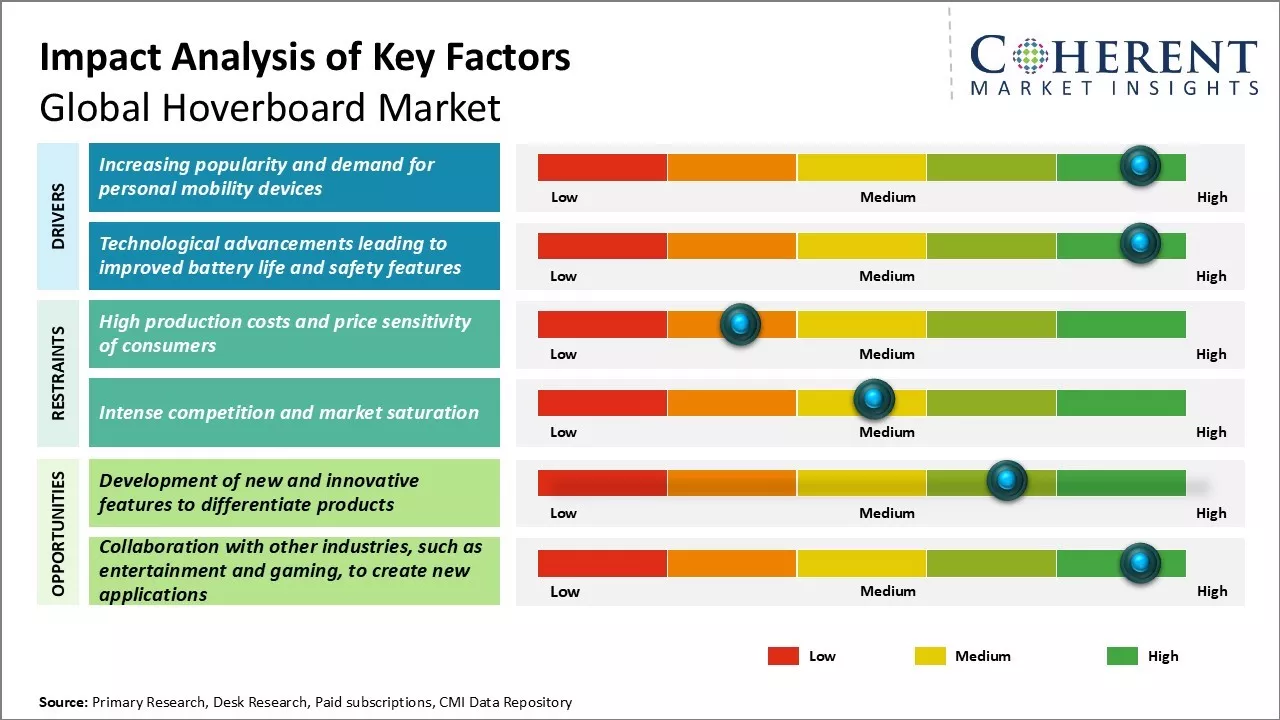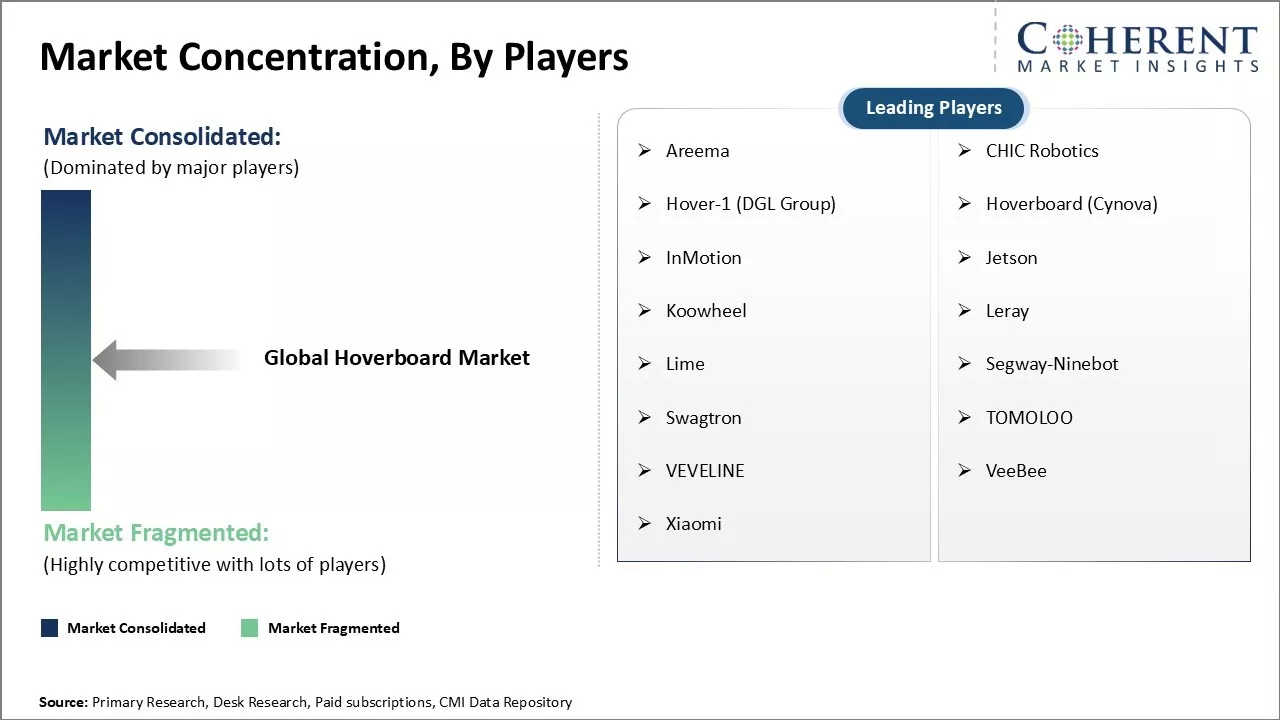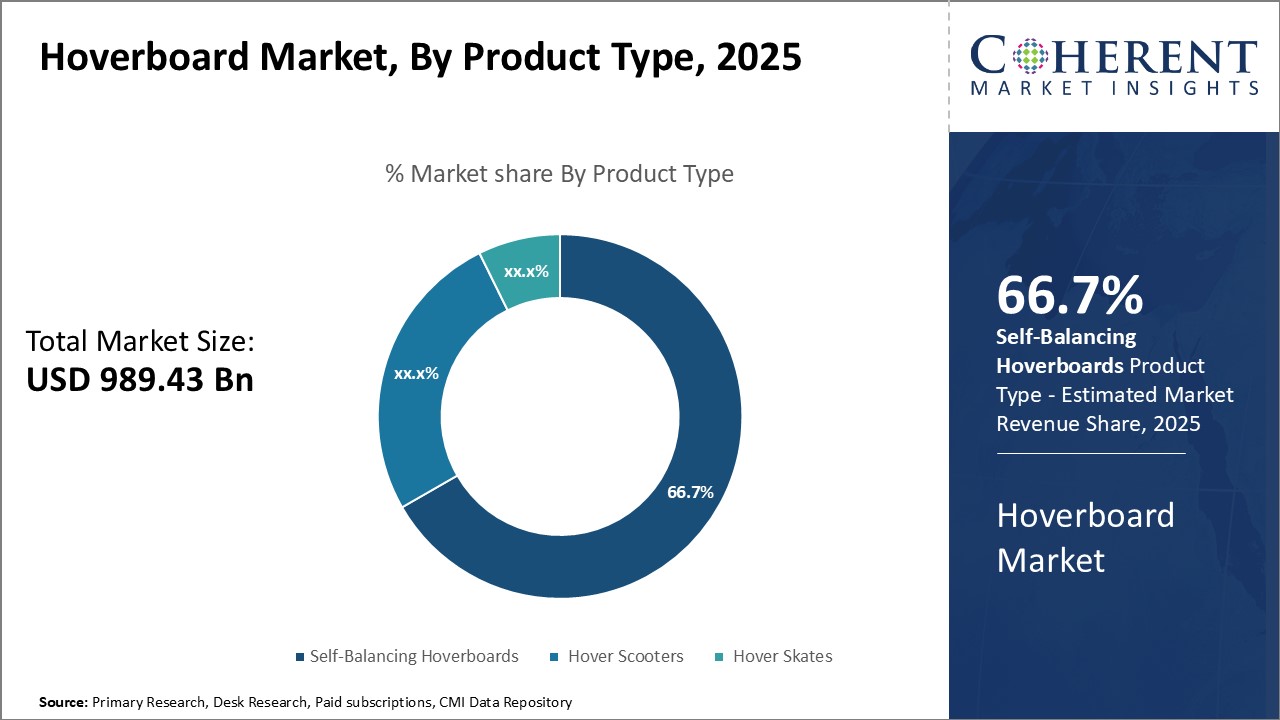The Global Hoverboard Market is estimated to be valued at USD 989.43 Bn in 2025 and is expected to reach USD 1,589.84 Bn by 2032, exhibiting a compound annual growth rate (CAGR) of 7.0% from 2025 to 2032.

Discover market dynamics shaping the industry: Request sample copy
The market has seen steady rise in recent years due to rising popularity among young adults and kid as form of recreational mobility solution.
Market Driver - Increasing popularity and demand for personal mobility devices
The mobility landscape is constantly changing as new forms of transportation emerge. One such innovation that has captured consumer interest is the hoverboard. Often touted as a fun, portable way to zip around town, these self-balancing electric scooters have become increasingly mainstream in recent years. Their compact size and ease of use make hoverboards appealing for navigating both outdoors and indoors.
Perhaps more so than any other personal vehicle, hoverboards conjure a sense of freedom and adventure. For many, riding one evokes feelings of carefree gliding that were once limited to childhood imaginings. Their playful nature has drawn in both young people eager to experience an exciting new hobby as well as nostalgia-seeking adults. Beyond offering simple recreation, hoverboards are also gaining popularity as an eco-friendly micro-mobility option for shorter trips typically made by car or other motorized transport. Their battery-powered operation produces zero direct emissions, helping users reduce their carbon footprint while traversing neighbourhood streets and trails.

Get actionable strategies to beat competition: Request sample copy
Advances Usher in an Improved Riding Experience
As with any emerging product category, safety has been a top priority for hoverboard manufacturers. Early models were sometimes prone to overheating or breaking, understandably creating hesitation among potential buyers. Today's devices reflect meaningful improvements thanks to continuous innovation. State-of-the-art lithium-ion battery technologies provide far greater reliability and lifespan between charges compared to initial hoverboard power sources. Rigorous testing and certification standards have also enhanced overall sturdiness, lowering the risk of accidents.
Riders now benefit from advanced balancing sensors and gyroscope mechanisms for smooth, precise control even at higher speeds. App-enabled features further upgrade the experience, allowing customization of settings as well as remote monitoring of battery levels and diagnostic data. Over-the-air updates also push new functionality and enhancements directly to devices. Water resistance on select models opens the door to fun excursions along paths and trails regardless of conditions. All told, technological refinements have made hoverboards a safer and more capable way to cruise around personally.
For instance, In January 2020, Segway-Ninebot, a global leader in the fields of intelligent short-distance transportation and service robotics, unveiled a new lineup of game-changing transportation products at CES 2020. Among these innovations was the Ninebot KickScooter T60, a revolutionary "roboscooter" designed with a reverse trike chassis. The T60 inherits the sturdy body, powerful drivetrain, excellent maneuverability, long-lasting range, and wireless charging capability from the shared scooter business model, but is tailored for consumers. The T60 aims to bring electric kickscooters to the next level by offering a better riding experience, improved portability, sleek and sturdy design, and smart capacity.
Key Takeaways from Analyst:
The global hoverboard market continues to see strong growth owing to increasing consumer interest in personalized urban mobility solutions. Rising adoption among youth and enthusiasts for both recreational and commuting purposes is propelling demand. Additionally, continuous advances in lithium-ion battery technology have enhanced hoverboard capabilities and expanded their use cases.
However, safety concerns surrounding hoverboard fires and related injuries remain a challenge. Stringent regulatory compliance and certification requirements are needed to address these risks and improve consumer safeguards. This could increase product and compliance costs which may hamper more penetration.
Nonetheless, ongoing innovation in form factors and features are helping hoverboards gain wider acceptance. The introduction of self-balancing designs as well as models with increased battery life and range have significantly boosted their appeal. Growing investments into R&D are also expanding product portfolios with advanced functionalities like mobile connectivity and home charging.
From a regional perspective, North America currently leads the hoverboard market supported by e-commerce penetration and high consumer spending on personal transportation gadgets. Meanwhile, the popularity of shared mobility in urban areas makes Asia Pacific fast-growing regional markets. As safety issues are progressively addressed, hoverboards could find more usage in inner-city delivery and cargo applications.
Market Challenges: High production costs and price sensitivity of consumers
One of the major challenges faced by the global hoverboard market is the high production costs associated with hoverboards and price sensitivity of consumers. Hoverboards use advanced technologies such as brushless motors, gyroscopic sensors and lithium-ion batteries to function. However, manufacturing hoverboards using these advanced components results in higher production costs. At the same time, consumers perceive hoverboards as recreational mobility devices and are very price sensitive towards the high price tags of hoverboards in the market. With the emergence of many local and international brands, consumers have started demanding affordable hoverboards. If the manufacturers are unable to reduce production costs and make hoverboards available at competitive prices, it can negatively impact the market growth in price sensitive domains. The industry needs to focus on collaborating with component suppliers and investing in R&D to develop cost-effective production techniques in order to address this challenge.
Market Opportunities: Development of new and innovative features to differentiate products
One of the major opportunities available for the global hoverboard market is the development of new and innovative features that can differentiate the products and attract more customers. In the nascent stage of market development, many local players as well as established brands are introducing hoverboards with basic functionality. However, to sustain intense competition and changing consumer preferences, the manufacturers need to continuously invest in R&D and innovation. Focusing on developing differentiated features such as improved battery life, variable speed control, Bluetooth connectivity, app-based services, and enhanced safety features provides huge opportunity. This will help brands to position their hoverboards with unique selling propositions. Moreover, it can also help in premium pricing of innovative products. The evolving customer demand for connected personalized mobility further boosts the opportunities for hoverboard manufacturers.

Discover high revenue pocket segments and roadmap to it: Request sample copy
Insights By Product Type - Self-Balancing Hoverboards Segment Leads Due to Safety and Convenience
In terms of Product Type, the Self-Balancing Hoverboards segment is estimated to hold the 66.7% share of the market in 2025 owing to their optimal balance of safety and convenience. Being self-balancing, they allow users to easily coast across flat surfaces with minimal risk of falling. This makes them suitable for both beginners and experienced riders of all age groups. Their stability and ease of use have made them a popular choice for recreation as well as niche commercial uses like security patrolling in open areas.
However, their fully balanced design also means Self-Balancing Hoverboards tend to be more expensive compared to other hoverboard variants. They also have weight and size restrictions that limit their suitability for commercial or industrial applications involving cargo transport or rough terrain navigation. Nevertheless, for casual personal transport within local communities, parks, and tourism hotspots, Self-Balancing Hoverboards remain the preferred choice due to safety and convenience.
Insights By Battery Type - Lithium-Ion Segment Leads Due to Superior Performance and Versatility
In terms of Battery Type, the Lithium-Ion segment is estimated to hold the 76.8% share of the market in 2025 due to its superior performance characteristics and adaptability. Lithium-Ion batteries provide higher energy density than other battery types, allowing hoverboards to travel longer distances on a single charge. They also recharge faster and suffer minimal loss of charge when not in use. This makes them very convenient for frequent recreation users. Lithium-Ion batteries are also lighter in weight, an important factor for hoverboards focusing on portability.
The modular, flexible nature of Lithium-Ion battery design also means they can be easily adapted to fit the power requirements of different hoverboard models. This provides manufacturers an edge over other battery types in designing and scaling their product lines. While Lithium-Ion batteries involve higher upfront costs, their superior performance and longer lifespans help offset this over the operational life of hoverboards. For these reasons, Lithium-Ion has emerged as the battery of choice for the majority of hoverboard manufacturers.
Insights By Application - Personal/Recreational Use Segment Leads Due to Affordable Entertainment and Fitness
In terms of Application, the Personal/Recreational Use segment is estimated to hold the 63.3% share of the market in 2025 as hoverboards provide an affordable and convenient way for fun transportation and exercise. For children and teenagers, it serves as a thrilling recreational activity that lays foundations for balance, coordination and motor skills. For busy adults, hoverboards offer an exciting commute alternative or tool for physical exercise and stress relief during weekend recreational activities with family and friends.
Being compact and portable, hoverboards can be conveniently folded and carried on public transportation or stored in small homes/apartments. Their ease of use requires minimal learning, allowing almost anyone to have instant fun on them without much practice. At an affordable price than most alternatives, hoverboards have enabled casual recreation to be accessible to mass market users of varied income levels and age groups globally. While commercial and industrial applications require specialized models catering to heavy-duty conditions, personal recreation remains the core application driving hoverboard designs, innovations and mass adoption worldwide.

Need a Different Region or Segment? Customize now
North America has emerged as the dominant region in the global hoverboard market with 39.0% share in 2025. The U.S., in particular, has seen significant adoption of hoverboards driven majorly by its tech-savvy population who are always early adopters of innovative consumer gadgets. Additionally, several leading hoverboard manufacturers have their headquarters in the U.S., which provides easy access to new models and designs. Stringent safety regulations enforced by regulatory bodies like the CPSC in the U.S. have also helped gain consumer trust in hoverboard brands. This has supported continual market growth over the last few years.
Another crucial factor for North America's dominance is aggressive promotional strategies employed by hoverboard sellers. Multiple consumer electronics stores stock a wide variety of hoverboards at competitive prices throughout the year. Collectively, these efforts have raised awareness and boosted impulse purchases in the region.
Among other regions, Asia Pacific is emerging as the fastest growing regional market for hoverboards. Countries like China and India are witnessing increased demand particularly from the youth population. Growing economy and rising disposable incomes have provided the necessary purchasing power. Further, increased urbanization is encouraging the adoption of personal mobility solutions like hoverboards for short commutes within cities. Presence of prominent hoverboard manufacturers has led to the availability of affordable models in Asia Pacific. Moreover, the region also serves as a major sourcing hub, meeting hoverboard demand through imports to Western markets. If the current growth momentum continues, Asia Pacific will play a bigger role in shaping the future dynamics of the global hoverboard industry.
Hoverboard Market Report Coverage
| Report Coverage | Details | ||
|---|---|---|---|
| Base Year: | 2024 | Market Size in 2025: | USD 989.43 Bn |
| Historical Data for: | 2020 To 2024 | Forecast Period: | 2025 To 2032 |
| Forecast Period 2025 to 2032 CAGR: | 7.0% | 2032 Value Projection: | USD 1,589.84 Bn |
| Geographies covered: |
|
||
| Segments covered: |
|
||
| Companies covered: |
Areema, CHIC Robotics, Hover-1 (DGL Group), Hoverboard (Cynova), InMotion, Jetson, Koowheel, Leray, Lime, Segway-Ninebot, Swagtron, TOMOLOO, VEVELINE, VeeBee, and Xiaomi |
||
| Growth Drivers: |
|
||
| Restraints & Challenges: |
|
||
Uncover macros and micros vetted on 75+ parameters: Get instant access to report
*Definition: The global hoverboard market refers to the worldwide industry for the manufacturing and sales of self-balancing scooters and electric skateboards commonly known as hoverboards. These battery-powered personal transportation devices use gyroscopic sensors and motors to allow individuals to smoothly ride and maneuver through balancing oneself, without the need for pushing with one's feet. The global hoverboard market has seen tremendous growth in recent years as the devices have increased in popularity among both adults and kids for recreation and short-distance mobility purposes.
Share
Share
About Author
Ramprasad Bhute is a Senior Research Consultant with over 6 years of experience in market research and business consulting. He manages consulting and market research projects centered on go-to-market strategy, opportunity analysis, competitive landscape, and market size estimation and forecasting. He also advises clients on identifying and targeting absolute opportunities to penetrate untapped markets.
Missing comfort of reading report in your local language? Find your preferred language :
Transform your Strategy with Exclusive Trending Reports :
Frequently Asked Questions
Joining thousands of companies around the world committed to making the Excellent Business Solutions.
View All Our Clients
US Reciprocal Tax Impact Analysis On Hoverboard Market
Stay updated on tariff changes with expert insights and timely information